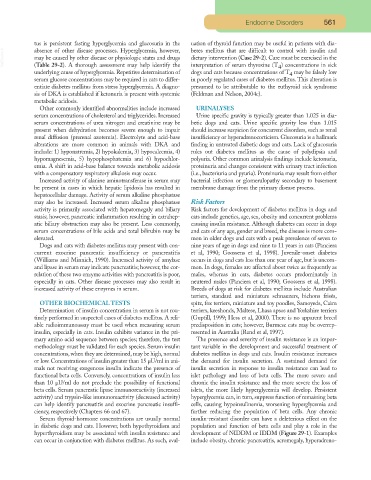Page 542 - Small Animal Clinical Nutrition 5th Edition
P. 542
Endocrine Disorders 561
tus is persistent fasting hyperglycemia and glucosuria in the uation of thyroid function may be useful in patients with dia-
VetBooks.ir absence of other disease processes. Hyperglycemia, however, betes mellitus that are difficult to control with insulin and
dietary intervention (Case 29-2). Care must be exercised in the
may be caused by other disease or physiologic states and drugs
(Table 29-2). A thorough assessment may help identify the
interpretation of serum thyroxine (T ) concentrations in sick
4
underlying cause of hyperglycemia. Repetitive determination of dogs and cats because concentrations of T may be falsely low
4
serum glucose concentrations may be required in cats to differ- in poorly regulated cases of diabetes mellitus. This alteration is
entiate diabetes mellitus from stress hyperglycemia. A diagno- presumed to be attributable to the euthyroid sick syndrome
sis of DKA is established if ketonuria is present with systemic (Feldman and Nelson, 2004c).
metabolic acidosis.
Other commonly identified abnormalities include increased URINALYSES
serum concentrations of cholesterol and triglycerides. Increased Urine specific gravity is typically greater than 1.025 in dia-
serum concentrations of urea nitrogen and creatinine may be betic dogs and cats. Urine specific gravity less than 1.015
present when dehydration becomes severe enough to impair should increase suspicion for concurrent disorders, such as renal
renal diffusion (prerenal azotemia). Electrolyte and acid-base insufficiency or hyperadrenocorticism. Glucosuria is a hallmark
alterations are more common in animals with DKA and finding in untreated diabetic dogs and cats. Lack of glucosuria
include: 1) hyponatremia, 2) hypokalemia, 3) hypocalcemia, 4) rules out diabetes mellitus as the cause of polydipsia and
hypomagnesemia, 5) hypophosphatemia and 6) hypochlor- polyuria. Other common urinalysis findings include ketonuria,
emia. A shift in acid-base balance towards metabolic acidosis proteinuria and changes consistent with urinary tract infection
with a compensatory respiratory alkalosis may occur. (i.e., bacteriuria and pyuria). Proteinuria may result from either
Increased activity of alanine aminotransferase in serum may bacterial infection or glomerulopathy secondary to basement
be present in cases in which hepatic lipidosis has resulted in membrane damage from the primary disease process.
hepatocellular damage. Activity of serum alkaline phosphatase
may also be increased. Increased serum alkaline phosphatase Risk Factors
activity is primarily associated with hepatomegaly and biliary Risk factors for development of diabetes mellitus in dogs and
stasis; however, pancreatic inflammation resulting in extrahep- cats include genetics, age, sex, obesity and concurrent problems
atic biliary obstruction may also be present. Less commonly, causing insulin resistance. Although diabetes can occur in dogs
serum concentrations of bile acids and total bilirubin may be and cats of any age, gender and breed, the disease is more com-
elevated. mon in older dogs and cats with a peak prevalence of seven to
Dogs and cats with diabetes mellitus may present with con- nine years of age in dogs and nine to 11 years in cats (Panciera
current exocrine pancreatic insufficiency or pancreatitis et al, 1990; Goossens et al, 1998). Juvenile-onset diabetes
(Williams and Minnich, 1990). Increased activity of amylase occurs in dogs and cats less than one year of age, but is uncom-
and lipase in serum may indicate pancreatitis; however, the cor- mon. In dogs, females are affected about twice as frequently as
relation of these two enzyme activities with pancreatitis is poor, males, whereas in cats, diabetes occurs predominately in
especially in cats. Other disease processes may also result in neutered males (Panciera et al, 1990; Goossens et al, 1998).
increased activity of these enzymes in serum. Breeds of dogs at risk for diabetes mellitus include Australian
terriers, standard and miniature schnauzers, bichons frisés,
OTHER BIOCHEMICAL TESTS spitz, fox terriers, miniature and toy poodles, Samoyeds, Cairn
Determination of insulin concentration in serum is not rou- terriers, keeshonds, Maltese, Lhasa apsos and Yorkshire terriers
tinely performed in suspected cases of diabetes mellitus. A reli- (Guptill, 1999; Hess et al, 2000). There is no apparent breed
able radioimmunoassay must be used when measuring serum predisposition in cats; however, Burmese cats may be overrep-
insulin, especially in cats. Insulin exhibits variance in the pri- resented in Australia (Rand et al, 1997).
mary amino acid sequence between species; therefore, the test The presence and severity of insulin resistance is an impor-
methodology must be validated for each species. Serum insulin tant variable in the development and successful treatment of
concentrations,when they are determined,may be high,normal diabetes mellitus in dogs and cats. Insulin resistance increases
or low. Concentrations of insulin greater than 15 µU/ml in ani- the demand for insulin secretion. A sustained demand for
mals not receiving exogenous insulin indicate the presence of insulin secretion in response to insulin resistance can lead to
functional beta cells. Conversely, concentrations of insulin less islet pathology and loss of beta cells. The more severe and
than 10 µU/ml do not preclude the possibility of functional chronic the insulin resistance and the more severe the loss of
beta cells. Serum pancreatic lipase immunoreactivity (increased islets, the more likely hyperglycemia will develop. Persistent
activity) and trypsin-like immunoreactivity (decreased activity) hyperglycemia can, in turn, suppress function of remaining beta
can help identify pancreatitis and exocrine pancreatic insuffi- cells, causing hypoinsulinemia, worsening hyperglycemia and
ciency, respectively (Chapters 66 and 67). further reducing the population of beta cells. Any chronic
Serum thyroid-hormone concentrations are usually normal insulin-resistant disorder can have a deleterious effect on the
in diabetic dogs and cats. However, both hypothyroidism and population and function of beta cells and play a role in the
hyperthyroidism may be associated with insulin resistance and development of NIDDM or IDDM (Figure 29-1). Examples
can occur in conjunction with diabetes mellitus. As such, eval- include obesity, chronic pancreatitis, acromegaly, hyperadreno-

